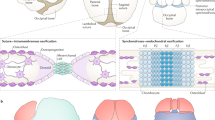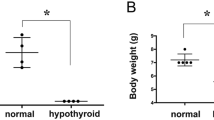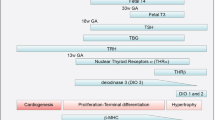Abstract
Thyroid hormones are important during development of the mammalian brain, acting on migration and differentiation of neural cells, synaptogenesis, and myelination. The actions of thyroid hormones are mediated through nuclear thyroid hormone receptors (TRs) and regulation of gene expression. The purpose of this article is to review the role of TRs in brain maturation. In developing humans maternal and fetal thyroid glands provide thyroid hormones to the fetal brain, but the timing of receptor ontogeny agrees with clinical data on the importance of the maternal thyroid gland before midgestation. Several TR isoforms, which are encoded by the THRA and THRB genes, are expressed in the brain, with the most common being TRα1. Deletion of TRα1 in rodents is not, however, equivalent to hormone deprivation and, paradoxically, even prevents the effects of hypothyroidism. Unliganded receptor activity is, therefore, probably an important factor in causing the harmful effects of hypothyroidism. Accordingly, expression of a mutant receptor with impaired triiodothyronine (T3) binding and dominant negative activity affected cerebellar development and motor performance. TRs are also involved in adult brain function. TRα1 deletion, or expression of a dominant negative mutant receptor, induces consistent behavioral changes in adult mice, leading to severe anxiety and morphological changes in the hippocampus.
Key Points
-
Thyroid hormones are important in brain development by regulating cell migration and differentiation, synaptogenesis, and myelination
-
The early steps of embryonic neural development, such as neural induction, neurulation, and establishment of polarity and segmentation, are probably not influenced by thyroid hormones
-
Deficient production of maternal thyroid hormones during the first half of gestation may lead to neurological deficits and is a primary factor in the pathogenesis of neurological cretinism
-
Gene regulation by thyroid hormones in brain follows a strict temporal and regional specificity; most genes are sensitive only during a limited time period of postnatal development, and some genes are under thyroid hormone control only in certain brain regions
-
Some of the morphological alterations induced by profound hypothyroidism might actually be a consequence of the altered transcriptional activity of unliganded receptors; receptor deletion is therefore not equivalent to hormone deprivation
-
Unlike deletion of the thyroid hormone receptor, expression of dominant negative receptors produces a phenotype more similar to the hypothyroid phenotype
This is a preview of subscription content, access via your institution
Access options
Subscribe to this journal
Receive 12 print issues and online access
$209.00 per year
only $17.42 per issue
Buy this article
- Purchase on Springer Link
- Instant access to full article PDF
Prices may be subject to local taxes which are calculated during checkout


Similar content being viewed by others
References
Bernal J (2005) Thyroid hormones and brain development. Vitam Horm 71: 95–122
Joffe RT and Sokolov ST (1994) Thyroid hormones, the brain, and affective disorders. Crit Rev Neurobiol 8: 45–63
Bauer M and Whybrow PC (2001) Thyroid hormone, neural tissue and mood modulation. World J Biol Psychiatry 2: 59–69
Yen PM (2001) Physiological and molecular basis of thyroid hormone action. Physiol Rev 81: 1097–1142
Nagy L and Schwabe JW (2004) Mechanism of the nuclear receptor molecular switch. Trends Biochem Sci 29: 317–324
McKenna NJ and O'Malley BW (2002) Combinatorial control of gene expression by nuclear receptors and coregulators. Cell 108: 465–474
Rosenfeld MG et al. (2006) Sensors and signals: a coactivator/corepressor/epigenetic code for integrating signal-dependent programs of transcriptional response. Genes Dev 20: 1405–1428
Davis PJ et al. (2005) Membrane receptors mediating thyroid hormone action. Trends Endocrinol Metab 16: 429–435
Cao X et al. (2005) Thyroid hormone induces rapid activation of Akt/protein kinase B-mammalian target of rapamycin-p70S6K cascade through phosphatidylinositol 3-kinase in human fibroblasts. Mol Endocrinol 19: 102–112
Storey NM et al. (2006) Rapid signaling at the plasma membrane by a nuclear receptor for thyroid hormone. Proc Natl Acad Sci USA 103: 5197–5201
Scanlan TS et al. (2004) 3-Iodothyronamine is an endogenous and rapid-acting derivative of thyroid hormone. Nat Med 10: 638–642
Silva JE and Matthews PS (1984) Production rates and turnover of triiodothyronine in rat-developing cerebral cortex and cerebellum. Responses to hypothyroidism. J Clin Invest 74: 1035–1049
Guadaño-Ferraz A et al. (1997) The type 2 iodothyronine deiodinase is expressed primarily in glial cells in the neonatal rat brain. Proc Natl Acad Sci USA 94: 10391–10396
Tu HM et al. (1997) Regional distribution of type 2 thyroxine deiodinase messenger ribonucleic acid in rat hypothalamus and pituitary and its regulation by thyroid hormone. Endocrinology 138: 3359–3368
Tu HM et al. (1999) Regional expression of the type 3 iodothyronine deiodinase messenger ribonucleic acid in the rat central nervous system and its regulation by thyroid hormone. Endocrinology 140: 784–790
Dumitrescu AM et al. (2004) A novel syndrome combining thyroid and neurological abnormalities is associated with mutations in a monocarboxylate transporter gene. Am J Hum Genet 74: 168–175
Friesema EC et al. (2004) Association between mutations in a thyroid hormone transporter and severe X-linked psychomotor retardation. Lancet 364: 1435–1437
Bernal J and Pekonen F (1984) Ontogenesis of the nuclear 3,5,3′-triiodothyronine receptor in the human fetal brain. Endocrinology 114: 677–679
Morreale de Escobar G et al. (2004) Role of thyroid hormone during early brain development. Eur J Endocrinol 151 (Suppl 3): U25–U37
Haddow JE et al. (1999) Maternal thyroid deficiency during pregnancy and subsequent neuropsychological development of the child. N Engl J Med 341: 549–555
Vermiglio F et al. (2004) Attention deficit and hyperactivity disorders in the offspring of mothers exposed to mild-moderate iodine deficiency: a possible novel iodine deficiency disorder in developed countries. J Clin Endocrinol Metab 89: 6054–6060
Vermiglio F et al. (1995) Maternal hypothyroxinaemia during the first half of gestation in an iodine deficient area with endemic cretinism and related disorders. Clin Endocrinol Oxf 42: 409–415
Fierro Benitez R et al. (1974) The clinical pattern of cretinism as seen in Highland Ecuador. Am J Clin Nutr 27: 531–543
Delong GR et al. (1985) Neurological signs in congenital iodine-deficiency disorder (endemic cretinism). Develop Med Child Neurol 27: 317–324
Yasuda T et al. (1999) Outcome of a baby born from a mother with acquired juvenile hypothyroidism having undetectable thyroid hormone concentrations. J Clin Endocrinol Metab 84: 2630–2632
Kester MH et al. (2004) Iodothyronine levels in the human developing brain: major regulatory roles of iodothyronine deiodinases in different areas. J Clin Endocrinol Metab 89: 3117–3128
Porterfield SP and Hendrich CE (1993) The role of thyroid hormones in prenatal and neonatal neurological development. Current perspectives. Endocrine Rev 14: 94–106
Legrand J (1984) Effects of thyroid hormones on central nervous system. In Neurobehavioral Teratology, 331–363 (Ed. Yanai J) Amsterdam: Elsevier Science Publishers
Koibuchi N et al. (2003) Current perspectives on the role of thyroid hormone in growth and development of cerebellum. Cerebellum 2: 279–289
Thompson CC and Potter GB (2000) Thyroid hormone action in neural development. Cereb Cortex 10: 939–945
Anderson GW et al. (2003) Control of thyroid hormone action in the developing rat brain. Thyroid 13: 1039–1056
Perez-Castillo A et al. (1985) The early ontogenesis of thyroid hormone receptor in the rat fetus. Endocrinology 117: 2457–2461
Bradley DJ et al. (1992) Spatial and temporal expression of α- and β-thyroid hormone receptor mRNAs, including the β2-subtype, in the developing mammalian nervous system. J Neurosci 12: 2288–2302
Howdeshell KL (2002) A model of the development of the brain as a construct of the thyroid system. Environ Health Perspect 110 (Suppl 3): 337–348
Morreale de Escobar G et al. (1990) Contribution of maternal thyroxine to fetal thyroxine pools in normal rats near term. Endocrinology 126: 2765–2767
Vulsma T et al. (1989) Maternal-fetal transfer of thyroxine in congenital hypothyroidism due to a total organification defect or thyroid agenesis. N Engl J Med 321: 13–16
Calvo RM et al. (2002) Fetal tissues are exposed to biologically relevant free thyroxine concentrations during early phases of development. J Clin Endocrinol Metab 87: 1768–1777
Galton VA et al. (1999) Pregnant rat uterus expresses high levels of the type 3 iodothyronine deiodinase. J Clin Invest 103: 979–987
Lavado-Autric R et al. (2003) Early maternal hypothyroxinemia alters histogenesis and cerebral cortex cytoarchitecture of the progeny. J Clin Invest 111: 1073–1082
Ausó E et al. (2004) A moderate and transient deficiency of maternal thyroid function at the beginning of fetal neocorticogenesis alters neuronal migration. Endocrinology 145: 4037–4047
Utiger RD (1999) Maternal hypothyroidism and fetal development. N Engl J Med 341: 601–602
Morreale de Escobar G et al. (2000) Is neuropsychological development related to maternal hypothyroidism, or to maternal hypothyroxinemia? J Clin Endocrinol Metab 85: 3975–3987
Forrest D and Vennstrom B (2000) Functions of thyroid hormone receptors in mice. Thyroid 10: 41–52
O'Shea PJ and Williams GR (2002) Insight into the physiological actions of thyroid hormone receptors from genetically modified mice. J Endocrinol 175: 553–570
Ercan-Fang S et al. (1996) Isoform specific 3,5,3′-triiodothyronine receptor binding capacity and messenger ribonucleic acid content in rat adenohypophysis: effect of thyroidal state and comparison with extrapituitary tissues. Endocrinology 137: 3228–3233
Yoshihara HA et al. (2003) Design and synthesis of receptor ligands. Methods Enzymol 364: 71–91
Baxter JD et al. (2004) Selective activation of thyroid hormone signaling pathways by GC-1: a new approach to controlling cholesterol and body weight. Trends Endocrinol Metab 15: 154–157
Morte B et al. (2002) Deletion of the thyroid hormone receptor α 1 prevents the structural alterations of the cerebellum induced by hypothyroidism. Proc Natl Acad Sci USA 99: 3985–3989
Manzano J et al. (2003) Differential effects of triiodothyronine and the thyroid hormone receptor β-specific agonist GC-1 on thyroid hormone target genes in the brain. Endocrinology 144: 5480–5487
Roberts MR et al. (2006) Making the gradient: thyroid hormone regulates cone opsin expression in the developing mouse retina. Proc Natl Acad Sci USA 103: 6218–6223
Gothe S et al. (1999) Mice devoid of all known thyroid hormone receptors are viable but exhibit disorders of the pituitary-thyroid axis, growth, and bone maturation. Genes Dev 13: 1329–1341
Wondisford FE (2003) Thyroid hormone action: insight from transgenic mouse models. J Investig Med 51: 215–220
Heuer H and Mason CA (2003) Thyroid hormone induces cerebellar Purkinje cell dendritic development via the thyroid hormone receptor α1. J Neurosci 23: 10604–10612
Flamant F et al. (2002) Congenital hypothyroid Pax8(−/−) mutant mice can be rescued by inactivating the TRα gene. Mol Endocrinol 16: 24–32
Yacubova E and Komuro H (2002) Intrinsic program for migration of cerebellar granule cells in vitro . J Neurosci 22: 5966–5981
Mittag J et al. (2005) Athyroid Pax8−/− mice cannot be rescued by the inactivation of thyroid hormone receptor α1. Endocrinology 146: 3179–3184
Muñoz A et al. (1993) Thyroid hormone receptor/c-erbA: control of commitment and differentiation in the neuronal/chromaffin progenitor line PC12. J Cell Biol 121: 423–438
Chassande O (2003) Do unliganded thyroid hormone receptors have physiological functions? J Mol Endocrinol 31: 9–20
Mai W et al. (2004) Thyroid hormone receptor α is a molecular switch of cardiac function between fetal and postnatal life. Proc Natl Acad Sci USA 101: 10332–10337
Hernandez A et al. (2006) Type 3 deiodinase is critical for the maturation and function of the thyroid axis. J Clin Invest 116: 476–484
Itoh Y et al. (2001) Brain glucose utilization in mice with a targeted mutation in the thyroid hormone α or β receptor gene. Proc Natl Acad Sci USA 98: 9913–9918
Weiss RE and Refetoff S (2000) Resistance to thyroid hormone. Rev Endocr Metab Disord 1: 97–108
Liu YY et al. (2003) A thyroid hormone receptor α gene mutation (P398H) is associated with visceral adiposity and impaired catecholamine-stimulated lipolysis in mice. J Biol Chem 278: 38913–38920
Liu YY et al. (2002) A targeted thyroid hormone receptor α gene dominant-negative mutation (P398H) selectively impairs gene expression in differentiated embryonic stem cells. Endocrinology 143: 2664–2672
Tinnikov A et al. (2002) Retardation of post-natal development caused by a negatively acting thyroid hormone receptor α1. EMBO J 21: 5079–5087
Venero C et al. (2005) Anxiety, memory impairment, and locomotor dysfunction caused by a mutant thyroid hormone receptor α1 can be ameliorated by T3 treatment. Genes Dev 19: 2152–2163
Guadaño-Ferraz A et al. (2003) Lack of thyroid hormone receptor α1 is associated with selective alterations in behavior and hippocampal circuits. Mol Psychiatry 8: 30–38
Gould E et al. (1990) Dendritic spine density of adult hippocampal pyramidal cells is sensitive to thyroid hormone. Brain Res 525: 327–329
Montero-Pedrazuela A et al. (2006) Modulation of adult hippocampal neurogenesis by thyroid hormones: implications in depressive-like behavior. Mol Psychiatry 11: 361–371
Ishizuka T and Lazar MA (2003) The N-CoR/histone deacetylase 3 complex is required for repression by thyroid hormone receptor. Mol Cell Biol 23: 5122–5131
de Graaf-Peters VB and Hadders-Algra M (2006) Ontogeny of the human central nervous system: what is happening when? Early Hum Dev 82: 257–266
Acknowledgements
I have been supported by grant BFU2005-01740 from the Ministry of Education and Science, Spain, and by the European Union Integrated Project LSHM-CT-2005-018652, CRESCENDO (Consortium for Research into Nuclear Receptors in Development and Aging).
Author information
Authors and Affiliations
Ethics declarations
Competing interests
The author declares no competing financial interests.
Rights and permissions
About this article
Cite this article
Bernal, J. Thyroid hormone receptors in brain development and function. Nat Rev Endocrinol 3, 249–259 (2007). https://doi.org/10.1038/ncpendmet0424
Received:
Accepted:
Issue Date:
DOI: https://doi.org/10.1038/ncpendmet0424
This article is cited by
-
Changes in brain structure in subjects with resistance to thyroid hormone due to THRB mutations
Thyroid Research (2023)
-
Brain nuclear receptors and cardiovascular function
Cell & Bioscience (2023)
-
Maternal thyroid hormone receptor β activation in mice sparks brown fat thermogenesis in the offspring
Nature Communications (2023)
-
Role and Clinical Significance of Monocarboxylate Transporter 8 (MCT8) During Pregnancy
Reproductive Sciences (2023)
-
Associations between paraben exposure, thyroid capacity, homeostasis and pituitary thyrotropic function in the general Taiwanese: Taiwan Environmental Survey for Toxicants (TEST) 2013
Environmental Science and Pollution Research (2023)



